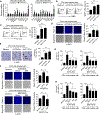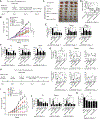Tumor extracellular vesicle-derived PD-L1 promotes T cell senescence through lipid metabolism reprogramming
- PMID: 39937879
- PMCID: PMC12063564
- DOI: 10.1126/scitranslmed.adm7269
Tumor extracellular vesicle-derived PD-L1 promotes T cell senescence through lipid metabolism reprogramming
Abstract
The limited success of cancer immunotherapy has posed challenges in treating patients with cancer. However, promising strides could be made with a deeper understanding of the factors that cause T cell dysfunction within the tumor microenvironment and by developing effective strategies to counteract tumor-induced immune suppression. Here, we report that tumor-derived extracellular vesicles (tEVs) can induce senescence and suppression in T cells. Programmed death ligand 1 (PD-L1), a key component within tEVs, induced DNA damage and hyperactive lipid metabolism in both human and mouse T cells. This caused an elevated expression of lipid metabolic enzymes and an increase in cholesterol and lipid droplet formation, leading to cellular senescence. At a molecular level, PD-L1 derived from tEVs activated the cAMP-response element binding protein (CREB) and signal transducer and activator of transcription (STAT) signaling, which promoted lipid metabolism and facilitated senescence in human and mouse T cells. Inhibiting EV synthesis in tumors or blocking CREB signaling, cholesterol synthesis, and lipid droplet formation in effector T cells averted the tEV-mediated T cell senescence in vitro and in vivo in cell adoptive transfer and melanoma mouse models. The same treatments also bolstered the antitumor efficacy of adoptive transfer T cell therapy and anti-PD-L1 checkpoint immunotherapy in both human and mouse melanoma models. These studies identified mechanistic links between tumor-mediated immune suppression and potential immunotherapy resistance, and they provide new strategies for cancer immunotherapy.
Conflict of interest statement
Figures








References
-
- Cagnoni AJ, Giribaldi ML, Blidner AG, Cutine AM, Gatto SG, Morales RM, Salatino M, Abba MC, Croci DO, Mariño KV, Rabinovich GA, Galectin-1 fosters an immunosuppressive microenvironment in colorectal cancer by reprogramming CD8+ regulatory T cells. Proc. Natl. Acad. Sci. U.S.A. 118, e2102950118 (2021). - PMC - PubMed
-
- Porta C, Consonni FM, Morlacchi S, Sangaletti S, Bleve A, Totaro MG, Larghi P, Rimoldi M, Tripodo C, Strauss L, Banfi S, Storto M, Pressiani T, Rimassa L, Tartari S, Ippolito A, Doni A, Soldà G, Duga S, Piccolo V, Ostuni R, Natoli G, Bronte V, Balzac F, Turco E, Hirsch E, Colombo MP, Sica A, Tumor-derived prostaglandin E2 promotes p50 NF-κB-dependent differentiation of monocytic MDSCs. Cancer Res. 80, 2874–2888 (2020). - PubMed
-
- Zhai L, Bell A, Ladomersky E, Lauing KL, Bollu L, Nguyen B, Genet M, Kim M, Chen P, Mi X, Wu JD, Schipma MJ, Wray B, Griffiths J, Unwin RD, Clark SJ, Acharya R, Bao R, Horbinski C, Lukas RV, Schiltz GE, Wainwright DA, Tumor cell IDO enhances immune suppression and decreases survival independent of tryptophan metabolism in glioblastoma. Clin. Cancer Res. 27, 6514–6528 (2021). - PMC - PubMed
MeSH terms
Substances
Grants and funding
LinkOut - more resources
Full Text Sources
Research Materials

